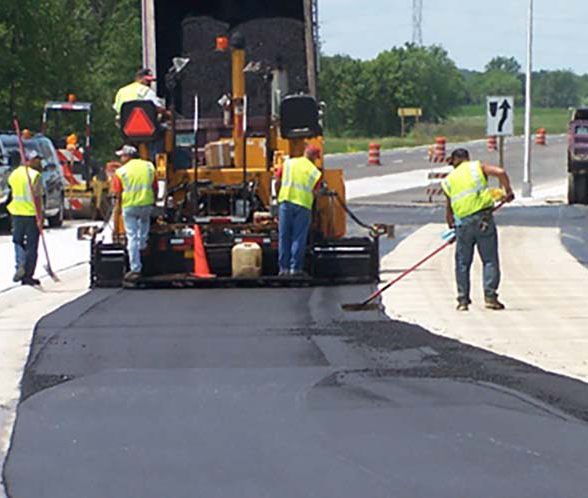Hot Mix Asphalt Paving: Elevating Commercial Parking Lot Specifications
Hot Mix Asphalt Paving: Elevating Commercial Parking Lot Specifications
Blog Article
Unlocking the Tricks of Hot Mix Asphalt Innovation
Checking out the midsts of hot mix asphalt innovation discovers a globe where careful procedures and exact solutions merge to form our roadways and infrastructure. The blend of fillers, accumulations, and binders isn't merely a building task however a strategic orchestration of toughness and effectiveness. As we peer into the intricate dance of parts, a tapestry of strength and sustainability unravels. What exists beneath this surface of asphaltic mastery, and what keys wait to be revealed in the realm of leading advancements?
Value of Hot Mix Asphalt
Warm Mix Asphalt plays an essential duty in contemporary framework advancement due to its toughness and cost-effectiveness. As the most frequently used paving product for roads, highways, and vehicle parking lots, Warm Mix Asphalt offers a variety of benefits that add to its value in construction jobs. One vital advantage is its capacity to endure rush hour tons and extreme climate problems, giving a long-lasting and trusted surface area for transport networks. In Addition, Hot Mix Asphalt is economical in both first construction and long-lasting upkeep, making it a preferred option for lots of infrastructure jobs.
The toughness of Warm Mix Asphalt stems from its structure, which includes accumulations, binder, and filler materials that are carefully picked and mixed to fulfill certain performance needs. Generally, the significance of Warm Mix Asphalt in facilities development can not be downplayed, as it continues to be a foundation of modern building and construction practices.
Components of Asphalt Mixes
The composition of asphalt mixes consists of very carefully picked aggregates, binder, and filler materials that are important for attaining details performance needs. Aggregates are the primary element of asphalt mixes, supplying toughness and security. The binder, typically bitumen or asphalt cement, holds the aggregates with each other and offers versatility and toughness to the mix.
The mix and percentage of these parts play a substantial duty in determining the quality and performance of the asphalt mix. Engineers very carefully create the mix to fulfill certain demands, thinking about aspects like web traffic volume, climate conditions, and pavement lifespan. Correct option and harmonizing of accumulations, binder, and fillers are necessary for producing resilient, lasting asphalt pavements.
Combining and Manufacturing Strategies

When the aggregates are selected, the binder, typically asphalt cement, is contributed to bind the materials together. The binder's top quality and quantity substantially impact the mix's strength, flexibility, and resistance to ecological variables. In addition, fillers like moisturized lime or Rose city concrete may be integrated to enhance specific characteristics go now of the asphalt mix, such as its workability or dampness resistance.
Throughout production, the aggregates and binder are warmed, commonly in between 250-325 ° F(121-163 ° C ), to promote blending and guarantee proper coating of the accumulations. The blending process has to be detailed to accomplish a homogeneous mix that promotes the wanted performance characteristics of the asphalt. Numerous methods, such as batch blending or drum mixing, are used to accomplish regular and top notch asphalt blends for building projects.
Aspects Affecting Asphalt Efficiency
Elements affecting asphalt performance incorporate an array of variables that affect the resilience, long life, and overall high quality of asphalt pavements. One crucial factor is the high quality of products utilized in the asphalt mix. The kind and source of accumulations, the binder high quality, and the ingredients all play a significant function in determining the performance of the asphalt sidewalk. The gradation of aggregates is critical as it affects the mix's security, resistance, and workability to rutting and cracking.

Environmental problems additionally influence asphalt efficiency. Temperature variants, wetness infiltration, and website traffic loads can all affect the Bonuses architectural stability of the sidewalk. Design considerations, such as sidewalk thickness and water drainage, are necessary in ensuring the long-lasting efficiency of the asphalt pavement. By very carefully taking into consideration these service providers, aspects and engineers can maximize asphalt performance and improve the solution life of sidewalks.
Lasting Practices in Asphalt Modern Technology

WMA enables for the production and placement of asphalt blends at lower temperature levels contrasted to conventional hot-mix asphalt, resulting in lowered energy consumption and greenhouse gas emissions. The use of porous asphalt mixes can aid minimize stormwater runoff problems by permitting water to infiltrate with the sidewalk and into the ground, promoting all-natural water purification and recharge procedures.
Verdict
Finally, hot mix asphalt technology plays a vital duty in modern-day infrastructure development due to its sturdiness and cost-effectiveness. By meticulously stabilizing parts, employing proper blending strategies, and considering various factors, designers can develop high-quality asphalt blends that withstand hefty website traffic lots and rough weather. Embracing sustainable techniques, such as making use of warm-mix innovations and recycled materials, further enhances the ecological kindness of asphalt innovation.
Mixing and production techniques in hot mix asphalt innovation involve the accurate combination and handling of accumulations, binder, and fillers to produce a high-performance and durable asphalt mix.Variables influencing asphalt performance incorporate a variety of variables that affect the sturdiness, longevity, and total high quality of asphalt pavements. Lasting methods in asphalt technology include various campaigns aimed at reducing the ecological impact of asphalt manufacturing and paving processes. By including reclaimed asphalt pavement (RAP) and recycled asphalt roof shingles (RAS) right into new asphalt mixes, the market can dramatically minimize the consumption of raw products and energy, while additionally decreasing land fill waste.
WMA permits for the manufacturing and placement of asphalt blends at reduced temperatures contrasted to conventional hot-mix asphalt, resulting in lowered energy usage and greenhouse gas exhausts.
Report this page